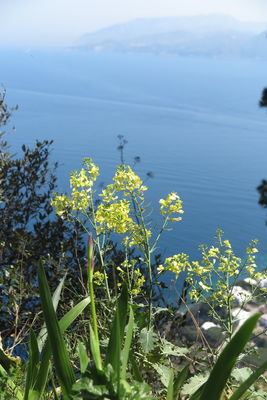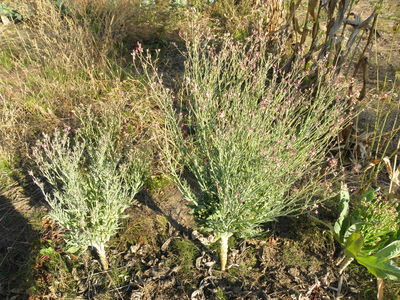Geography and distribution
Brassica oleracea is native to the Mediterranean region and southwestern Europe, as far north as southern England. It is found growing wild on seaside cliffs.
Description
Overview: Biennial or perennial herb, to 250 cm tall when in flower. Smooth, more or less woody, stem.
Leaves: Few (in comparison to cultivars), fleshy, hairless, lobed, blue-green leaves. Lower leaves stalked and fairly large (up to 45 cm long), with irregular wavy margins.
Flowers: With four pale yellow petals and six stamens (two outer ones shorter than four inner ones). Borne on flowering stems of 20-40 individual flowers.
Fruits: A short-beaked siliqua (fruit divided into two cells by a thin partition) up to 10 cm long, round in cross-section.
Uses Food
Brassica vegetables are consumed in large quantities across the globe. They are an important source of dietary fibre, vitamins C and E, a range of B vitamins and carotenes. Their distinctive bitter flavour is due to the presence of glucosinolates, which can be toxic in certain circumstances but are also credited with potential anti-cancer activity.
Fodder
Marrow-stem kale, 1000-headed kale and kohlrabi are examples of cultivars grown for livestock feed and forage; kohlrabi is also eaten by humans as a raw and cooked vegetable.
Ornamental
Cabbages with white, pink, green and purple foliage, sometimes with fringed margins, are cultivated as ornamentals. They are considered to be attractive in garden borders and are sometimes used in fresh flower arrangements. Ornamental kales with white or pink markings on the leaves are available.
Cabbage cultivar groups
There are considered to be eight main cultivar groups:
Acephala Group (kale, borecole, collards)
Also known as winter greens, these non-heading cultivars are probably the most similar in appearance to wild cabbage. Cultivars with coloured leaves are grown as ornamentals. Jersey longjacks have tall, woody stems that are used for walking-sticks. Other cultivars are grown for livestock feed and forage.
Alboglabra Group (Chinese kale, Chinese broccoli, gai laan, kai lan)
Leaves of these cultivars are used in Chinese, Vietnamese and Thai cuisine.
Botrytis Group - (broccoli, cauliflower, broccoflower, calabrese)
Bearing edible inflorescences in compact heads, these are popular vegetables served raw or boiled and are often accompanied with a white sauce. They are also used in pickles. Forms of cauliflower suitable for hot and humid climates have been developed in India over the past 200 years.
Capitata Group (cabbage, savoy cabbage, red cabbage)
Developed in Germany by the 12th century, these have a large, edible, terminal bud. Savoy cabbage has puckered leaves and is shredded for use in coleslaw. Red cabbage contains the pigment anthocyanin and is used for pickling. Sauerkraut is fermented shredded cabbage leaves that is popular in Germany and some other European countries.
Gemmifera Group (sprouts, Brussels sprouts)
Developed in Belgium in the 18th century, this form has dense, compact, axillary buds (like mini-cabbages) packed tightly on a single, upright stem.
Gongylodes Group (kohlrabi, knol-kohl)
Bearing a white, green or purple, turnip-like, edible swollen stem (5-12 cm wide).These first appeared in Europe in the 15th century and are consumed as a boiled vegetable or used as livestock-feed.
Italica Group (purple sprouting, sprouting broccoli)
Bearing edible inflorescences not compacted into a single head, these cultivars became popular in northern Europe in the 18th century. They are alleged to reduce the incidence of bladder and colorectal cancers.
Tronchuda Group (Portuguese cabbage, seakale cabbage)
Low-growing annuals with spreading leaves, fleshy petioles and broad midribs.
Millennium Seed Bank: Seed storage
The Millennium Seed Bank Partnership aims to save plant life worldwide, focusing on plants under threat and those of most use in the future. Seeds are dried, packaged and stored at a sub-zero temperature in our seed bank vault.
More than 20 collections of Brassica oleracea seeds are held in Kew's Millennium Seed Bank based at Wakehurst in West Sussex.
This species at Kew
Brassica oleracea 'Kamome Red' (ornamental kale)
Brassica oleracea can usually be seen growing in the Plant Family Beds and Student Vegetable Plots at Kew.
Dried and alcohol-preserved specimens of Brassica oleracea are held in Kew's Herbarium where they are available to researchers by appointment. The details of one of these can be seen online in Kew's Herbarium Catalogue.
Specimens of Brassica oleracea seeds and seed oil, Jersey cabbage walking sticks and wool dyed with it are held in Kew's Economic Botany Collection, where they are available to researchers by appointment.






